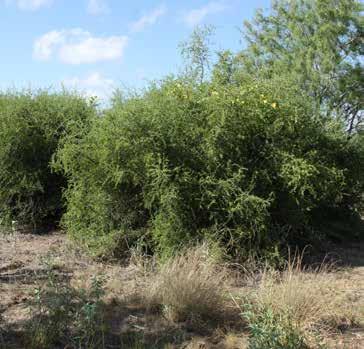
2 minute read
Plant Profile
Snake-eyes
Article by ERIC GRAHMANN, PH.D.
The foliage and fruit of snake-eyes.

Photo by John Yochum
Photo by Eric Grahmann
Snake-eyes plants. These are about as large as the the plant grows. In most dice games, rolling a pair of “snake-eyes,” the lowest possible roll, usually means a loss. But in ocelot habitat and areas surrounding the Rio Grande Valley, snake-eyes is a winner every time.
Snake-eyes (Phaulothamnus spinescens), or Putia as it is locally called, is a shrub found in the mixed thornscrub of deep South Texas (the Rio Grande Valley west to Laredo and then north to the Corpus Christi area) from the extremely dense woodlands where ocelot reside to more open thornscrub savannah. The genus Phaulothamnus is of Greek origin and indicates an unattractive shrub that is unpleasant to handle. But then again, what plant is pleasant to handle in South Texas?
Snake-eyes is a woody species that can grow to about 8 feet tall. The leaves, which can measure up to 1 inch long, are greyish green, smooth to fuzzy, spatulate (teardrop) in shape and originate from the stem as a rosette. The stems are greyish to occasionally sooty-black in coloration with terminal spines on the ends.
Plants are dioicous, meaning there are both male and female plants; both sporting tiny-green flowers of their own make. The unmistakable fruit on female plants is called a drupe, with translucid pulp revealing a single black seed inside which resembles a “googley-eyed snake”.
In most cases, when snake-eyes is found, you know you’ve found a special plant community. The plant disappears in areas that have seen root-plowing or other invasive types of land clearing or degradation. Areas that support snake-eyes are almost always hyper-diverse in their plant community assemblage.
Fruit of snake-eyes is consumed by many species of birds, including Long-billed Thrasher, White-tipped Dove and Plain Chachalaca, while the flowers attract a myriad of pollinators. The foliage of snake-eyes is intermediate in palatability to whitetailed deer and browsing livestock.
Along with many other shrub species in South Texas, the plant is valuable in the cover it provides to both predator and prey alike. So, no need to jump out of fear when you see these snake-eyes in South Texas, instead jump for joy as you’ve just discovered something special.











